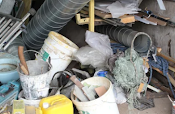Hoarding
- Hoarding is a condition that has received increased research attention in recent years. It was originally thought of as a symptom of OCD but now is considered a separate disorder.
- Compulsive hoarding occurs in approximately 3 to 5 percent of adults and in 10 to 40 percent of people diagnosed with OCD.
- People with hoarding disorder acquire and fail to discard many possessions that are of limited value.
- Their homes are extremely cluttered and disorganized so much that it interferes with their daily activities. Some people have been buried alive in their homes by their possessions.
- Neuroimaging research has found that people with compulsive hoarding show patterns of brain activation that are different from people with OCD who do not have hoarding symptoms.
- Compulsive hoarding is associated with an increased risk of fire, falling, poor sanitation, and serious health problems.
- At-home treatments that include home visits have shown some effectiveness. These treatments work partially by changing the patient's beliefs about the importance of saving each of their possessions.
References
Hooley, J. M., Nock, M. K., & Butcher, J. N. (2019). Abnormal Psychology (18th ed.). Pearson Education (US). https://bookshelf.vitalsource.com/books/9780135191033





No comments:
Post a Comment